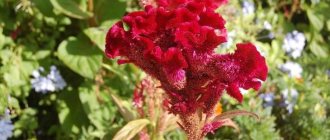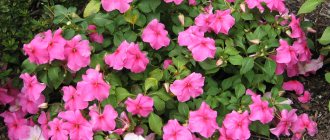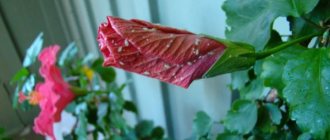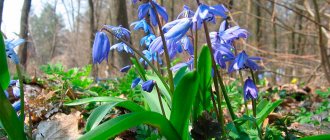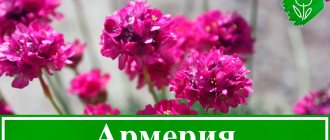The herbaceous annual and perennial plant chrysanthemum (Chrysanthemum) is a member of the Asteraceae family. From Greek, the name of the plant is translated as “sun flower” or “golden flower”; the fact is that in most species the inflorescences are yellow. According to the GRIN website, this genus unites approximately 29 species that are naturally found in the temperate and northern zones, and most often in Asia. Archaeologists are confident that the ancient Chinese grew chrysanthemums more than 2.5 thousand years ago; they ate the petals of this plant. The chrysanthemum was also mentioned by Confucius himself in the treatise “Spring and Autumn”. Later, the Japanese began to grow the plant, who idolized the chrysanthemum so much that only members of the imperial family had the right to wear clothes with its image. The flower appeared in Europe only in the 18th century, but it became popular among gardeners only in the 19th century. Today, the garden chrysanthemum (Chrysanthemum hortorum) is the most popular among gardeners; scientists believe that it was formed as a result of crossing two Asian species: the large-flowered chrysanthemum (Chrysanthemum morifoolium), which is native to China, and the small-flowered chrysanthemum (Chrysanthemum indicum) from Japan . However, some experts believe that the garden chrysanthemum appeared due to the crossing of the Chinese chrysanthemum and the small-flowered Indian chrysanthemum. There are a huge number of chrysanthemum varieties, and breeders are still working on developing new unusual varieties.
Brief description of cultivation
- Landing . In April, seedlings are sown, and in May, the seeds are sown in open soil. Sowing can be done before winter, but no later than 15 days before the first frost.
- Bloom . In the last weeks of summer and autumn.
- Illumination . Needs plenty of bright sunlight.
- Soil . The land should be fertile, dry, well-permeable, neutral or slightly acidic, loamy.
- Watering . Needs abundant watering.
- Fertilizer . Three times during the season, for this they alternately use organic and mineral fertilizers in liquid form. Fertilizers are applied to the soil for the first time seven weeks after planting.
- Reproduction . Annual species and varieties are propagated only by seeds, and perennials - mainly by cuttings and dividing the bush.
- Harmful insects . Nematodes, aphids, meadow bugs.
- Diseases . Gray rot, rust, septoria, powdery mildew, bacterial root canker.
Notes
- For the convention of indicating the class of dicotyledons as a superior taxon for the group of plants described in this article, see the section “APG Systems” of the article “Dicotyledons”.
- See the link on the GRIN
in the Links section. - Nedoluzhko A. I.
[www.treefrog.ru/images/stories/Nedoluzhko/nedoluzhko-chrysanthemum.pdf Chrysanthemums for Primorye] / Moskaluk T. A. - Vladivostok: BSI FEB RAS, 2004. - 51 p. - [www.theplantlist.org/1.1/browse/A/Compositae/Chrysanthemum/ Chrysanthemum] at [www.theplantlist.org The Plant List]
- Korean chrysanthemum is called both the species Chrysanthemum coreanum
and
Chrysanthémum ×koreanum
- a group of hybrids and varieties of the genus
Chrysanthemum
, characterized by increased winter hardiness.
Features of chrysanthemum
Chrysanthemums are represented by perennial or annual subshrubs and herbaceous plants. The branched rhizome grows parallel to the soil surface. The surface of the stems may have pubescence, but they may also be bare. Simple alternately arranged bare or pubescent leaf plates differ in size and shape: jagged, notched or dissected. As a rule, the foliage is greenish in color, but it can also be dark green. Most often, small flowers are part of an inflorescence-basket, which in some cases can be quite large. The basket consists of single-row reed-shaped marginal and central tubular flowers, but in most hybrid varieties they are arranged in multi-rows, resulting in the formation of a lush inflorescence called terry chrysanthemum. The fruit is an achene. Today, gardeners cultivate varieties and species of the so-called mulberry chrysanthemum, or garden chrysanthemum. It is also sometimes called Chinese chrysanthemum. This group of varieties and hybrids is very complex, and they also have a complicated history.
Chrysanthemums. Features, care and reproduction
Kinds
List of species according to The Plant List[4]:
- Chrysanthemum achillaea
Linn. - Chrysanthemum alabasicum
(HCFu) H. Ohashi & Yonek. - Chrysanthemum alabasium
(HC Fu) H. Ohashi & Yonekura - Chrysanthemum brachyanthum
(C.Shih) H.Ohashi & Yonek. - Chrysanthemum carinatum
Schousb. - Chrysanthemum chalchingolicum
Grubov - Chrysanthemum coreanum
(H.Lév. & Vaniot) Nakai - Korean Chrysanthemum[5] - Chrysanthemum coronarium
- Crowned chrysanthemum - Chrysanthemum decaisneanum
NEBr. - Chrysanthemum delavayanum
H.Ohashi & Yonek. - Chrysanthemum dichrum
(C.Shih) H.Ohashi & Yonek. - Chrysanthemum fastigiatum
(C. Winkl.) H. Ohashi & Yonek. - Chrysanthemum ×grandiflorum
Ramat. - Chrysanthemum hypoleucum
(C.Shih) H.Ohashi & Yonek. - Chrysanthemum indicum
L. - Chrysanthemum junnanicum
(Poljakov) H.Ohashi & Yonek. - Chrysanthemum kelleri
Krylov & Plotn. - Chrysanthemum kinokuniense
(Shimot. & Kitam.) H. Ohashi & Yonek. - Chrysanthemum konoanum
Makino - Chrysanthemum lineare
Matsum. - Chrysanthemum marginatum
(Miq.) NEBr. - Chrysanthemum mawei
Hook.f. - Chrysanthemum maximum
L. - Chrysanthemum miyatojimense
Kitam. - Chrysanthemum morifolium
Ramat. — Chrysanthemum mulberry - Chrysanthemum multifidum
Desf. - Chrysanthemum nitidum
(C.Shih) H.Ohashi & Yonek. - Chrysanthemum parvifolium
Chang - Chrysanthemum przewalskii
(Poljakov) H.Ohashi & Yonek. - Chrysanthemum purpureiflorum
H.Ohashi & Yonek. - Chrysanthemum ramosum
(CCChang) H. Ohashi & Yonek. - Chrysanthemum rhombifolium
H. Ohashi & Yonek. - Chrysanthemum roborowskii
(Muldashev) H.Ohashi & Yonek. - Chrysanthemum ×rubellum
Sealy - Chrysanthemum segetum
L. - Chrysanthemum shihchuanum
H.Ohashi & Yonek. - Chrysanthemum shimotomaii
Makino - Chrysanthemum ×superbum
Bergmans ex JWIngram - Chrysanthemum trilobatum
(Poljakov ex Poljakov) H.Ohashi & Yonek. - Chrysanthemum tripinnatisectum
H.Ohashi & Yonek. - Chrysanthemum vestitum
(Hemsl.) Stapf - Chrysanthemum yoshinyanthemum
Makino - Chrysanthemum zawodskii
Herbich
Growing chrysanthemums from seeds
Sowing in the ground
The easiest way to propagate chrysanthemums is by dividing the bush and cuttings. However, very often, a chrysanthemum grown from a seed becomes the pride of a gardener. Seeds are used to propagate both annuals and perennials, for example, Korean chrysanthemum. Below we will talk about growing such a flower from seeds using annuals as an example.
In May, after the return frosts are left behind, planting holes must be made on the site, the distance between which should be from 20 to 25 centimeters. They are spilled with lukewarm water and 2 or 3 seeds are placed in them. When the holes are filled with soil, you need to cover them on top with garden film, thereby you will be able to retain the moisture and heat necessary for seed germination in the soil. After the first seedlings appear, the cover is removed, and the surface of the soil in the area is carefully loosened, removing all the weeds. A week and a half after the emergence of seedlings, fertilizing is carried out with a very weak concentration of “Rainbow” or “Ideal” solution.
After the seedlings reach a height of 70 to 100 mm, they are thinned out. As a result, in each hole there should remain one of the strongest plants with 3 or 4 true leaf blades formed. If desired, excess seedlings can be transplanted to another location. Annual chrysanthemums grown from seeds will begin to bloom in August. In order for the bushes to please with early flowering, they are grown through seedlings.
Sowing seedlings
To grow seedlings, you will need low boxes filled with a substrate that includes humus, greenhouse soil and peat (1:1:1). The soil mixture can be bought at a specialized store, where it has already been disinfested and disinfected. The substrate prepared by yourself must be sifted and calcined at a temperature of 110 to 130 degrees. At the bottom of the box, first make a good drainage layer from expanded clay or pieces of brick. It is covered with prepared substrate, and seed material is evenly distributed on its surface. When sowing perennial seeds, they are not poured on top, but only lightly pressed into the soil mixture. And when sowing annuals, the seed material is sprinkled on top with a half-centimeter layer of substrate. Water the crops with a sprayer with lukewarm water and cover the container with film (glass) on top. Place the crops in a warm place (from 23 to 25 degrees), ventilate them systematically and moisten the substrate with a spray bottle, preventing it from drying out. If everything is done correctly, the first seedlings should appear 10–15 days after sowing. As soon as this happens, the box is moved to a well-lit place. The shelter is not removed immediately, but gradually, so that the plant has time to get used to the new conditions. To begin with, the shelter is removed for 1 hour, then for a couple of hours, and so on, until the plants get used to the new growth conditions.
If excessively dense seedlings appear after they have grown, they are planted in individual cups with the same substrate that is used for sowing seeds. This is done after the plants have formed from 2 to 4 true leaf blades; during transplantation, try not to injure their root system. Before starting picking, water the soil mixture in the box generously. During transplantation, discard plants that are too weak and elongated. In order for the seedlings to take root faster, after transplanting they are moistened from a sprayer with a solution of Epin or Zircon.
About sowing in detail!!! We grow chrysanthemums from seeds.
Seedling care
After picking, the seedlings are removed to a cool (16 to 18 degrees) and well-lit place. Watering is carried out only when necessary, and fertilizing is carried out regularly once every 2 weeks, for this purpose a solution of complex mineral fertilizer is used. If necessary, illuminate the seedlings with fluorescent lamps. Remember that seedlings of such a crop are characterized by extremely slow growth, so after 6 weeks their height reaches only about 20 centimeters.
Literature[ | ]
- Chrysanthemum // Botanical dictionary / comp. N. I. Annenkov. - SPb.: Type. Imp. AN, 1878. - XXI + 645 p.
- Chrysanthemum // Encyclopedic Dictionary of Brockhaus and Efron: in 86 volumes (82 volumes and 4 additional). - St. Petersburg, 1903. - T. XXXVIIa.
- Nedoluzhko A. And
Chrysanthemums for Primorye. - Vladivostok: BSI FEB RAS, 2004. - 51 p. - Nedoluzhko A.I.
The genus
Chrysanthemum
L. in the south of the Russian Far East (introduction opportunities, variability resources, selection, conservation of the gene pool) (inaccessible link). Abstract of the dissertation for the degree of Doctor of Agricultural Sciences. - Michurinsk: Naukograd, 2010. - Shmygun V. M.
Chrysanthemums. - GBS AS USSR. - M.: Nauka, 1972. - 116 p. - Pavlova T.
Chrysanthemums: Siberian hybrids. // Floriculture. - 1996. - No. 6. - Alexandrova L.
Growing with a rug. // AIF at the dacha. - 2000. - No. 23.
Planting in open ground and propagation
What time to plant
Chrysanthemum seedlings are planted in the spring after warm weather sets in and spring frosts are left behind. As a rule, this time falls on the last days of May or the first days of June. You can plant seedlings in the fall, but no later than half a month before the first frost.
When choosing a site for planting, you need to take into account that the crop loves light and warmth, and it reacts extremely negatively to stagnation of liquid in the root system. In this regard, the site must be elevated, have protection from gusts of wind, and be illuminated by the sun for at least 5 hours a day. It is best if the soil is fertile, loamy, slightly acidic or neutral. Clay or sandy soil must be improved by adding organic matter. However, fresh manure cannot be added to the soil; it should be replaced with vermicompost or humus. Organic matter and mineral complex fertilizers should be added to the soil immediately before planting seedlings. Please note that if there are a lot of nutrients in the soil, then the bushes will begin to actively grow green mass, which will have a very bad effect on flowering.
Landing rules
It is recommended to plant chrysanthemum seedlings in the garden on a rainy or cloudy day. It is more convenient to plant bushes in a trench rather than in planting holes, and a distance of 0.3 to 0.5 m should be left between them (depending on the type and variety). In order for the planted seedlings to take root faster, they are spilled with Kornevin solution (1 gram per 1 liter of water). When the plants are planted and watered, they are pinched, to do this the growing point is removed. Then it is recommended to cover the seedlings with any covering material, for example, lutrasil. This will create a favorable microclimate, which seedlings need for normal rooting and growth. After the chrysanthemum takes root and begins to grow, the shelter is removed.
How to plant chrysanthemums in autumn
Propagation by cuttings
The culture can also be propagated by cuttings. They are harvested in the spring after the air warms up to 21–26 degrees during the day and the return spring frosts have passed. To do this, use a sharp sterilized knife, which is used to cut cuttings from an adult bush, while using those stems that grow from the root of the flower; the lateral shoots are not suitable for this purpose. The cutting should reach 60 to 70 mm in length, and the cut should be made a few millimeters above the bud with the leaf. The lower end of the cutting is treated with a growth stimulating agent, for example, root. After this, it is planted in a container at an angle of 35–45 degrees, which is filled with moistened fertile soil mixture, sprinkled with a two-centimeter layer of sand on top. Plant the cuttings so that they are only in the sand, without touching the substrate. During rooting, the cuttings are placed on a well-lit windowsill, while making sure that the substrate in the container is slightly damp at all times. The optimal air temperature for rooting is from 15 to 18 degrees. If everything is done correctly, the roots will grow after 15–20 days, after which the cuttings are transplanted into open soil.
Gorgeous chrysanthemums - balls How to grow multiflora chrysanthemum from cuttings
Main varieties
A popular variety in the perennial chrysanthemum category is Early Yellow. In its external characteristics it is similar to the Japanese anemone. Bush chrysanthemums are perfect for cutting, forming bouquets, and arranging a garden landscape. All photos with her turn out juicy and rich.
Variety Early Yellow
The so-called spherical chrysanthemum has the shape of a ball due to the very dense fit of the petals. Bristly white chrysanthemums were able to embody all the lightness and tenderness of autumn flowers. Their petals are unusually thin, slightly curled. And if you look closely, they look somewhat like brushes.
Globular variety of chrysanthemums
The pompom pink chrysanthemum has a simply perfect spherical shape. The shades are always vibrant and the terry texture is surprisingly thick. Even in the most extreme conditions, the crop will still bloom!
Chrysanthemum pompom
Semi-double chrysanthemum flowers are one of the most numerous groups. They are characterized by a wealth of colors and shapes and almost always an open middle. The shades and structure of the petals can be the most unexpected.
Semi-double chrysanthemum
Simple varieties are characterized by the same simplified, uncomplicated shapes and colors. The inflorescences are light, graceful, somewhat reminiscent of a garden chamomile.
Simple chrysanthemum
The convex shape of the core of the inflorescence and the pleasant, fragrant smell indicate that this is an anemone-like variety.
You rarely see spoon-shaped chrysanthemums in the garden. They are considered a very rare variety. How is the flower connected to the spoon? It's simple - each petal looks like a teaspoon.
Spoon chrysanthemum
Caring for garden chrysanthemum
Even an amateur gardener can grow a chrysanthemum in his garden, but in order for the bushes to be as lush, beautiful and disease-free as possible, you need to know a few tricks. For example, after seedlings planted in open soil have taken root well, become stronger and have formed their eighth true leaf plate, they are pinched to make the bushes more lush. Soon side shoots should appear on the plant, when this happens, they are also pinched, as a result, your area will be decorated with spectacular dense bushes, and when flowers appear on them, they will look like fluffy balls.
When growing large-flowered varieties, you need to pay attention to the fact that it is recommended to remove all side shoots, leaving only a few of the most powerful ones. Cut shoots can be used as cuttings; they give roots very quickly. Some vigorous varieties require support; for this, you can install a net, metal pegs or a wire structure near the bush. It will support the bush and prevent it from falling apart.
Watering
The crop must be watered regularly and abundantly; if the plants do not have enough moisture, then their shoots will become woody and the inflorescences will not be so beautiful. The bushes should be watered with rain or well-settled water (it can be mixed with 2 drops of ammonia). Water is poured under the root, try not to get it on the surface of the leaf plates. After watering, the surface of the earth around the bushes is loosened, and all weeds are removed. In order to make caring for the plant easier, immediately after planting the seedlings, cover the surface of the area with a layer of mulch.
Fertilizer
In order for the bushes to grow and develop normally, they are systematically fed. During the growing season, flowers are fed at least 3 times; for this, organic matter and mineral fertilizers are alternately used. At the beginning of the growing season, the bushes need nitrogen; ammonia nitrogen is best suited for this; thanks to this feeding, the bushes will quickly increase their green mass. To stimulate lush flowering, chrysanthemums are fed with potassium-phosphorus fertilizer during the formation of buds.
For feeding, liquid nutrient solutions are used; they are poured at the root of the bushes the next day after watering or rain. The plants are fed for the first time in the first 1.5–2 months after they are planted in open ground. From organic matter, you can use burnt mullein or bird droppings. Experienced gardeners say that it is better not to feed the chrysanthemum rather than to burn it.
Chrysanthemum multiflora, feeding during flowering.
Transfer
A flower can be grown in the same place for no longer than 3 years, otherwise it will begin to “be capricious”, namely: the inflorescences will begin to shred, and it will also get sick much more often. In this regard, in spring it is necessary to remove an adult bush (over three years old) from the ground and replant it.
As a rule, this procedure is carried out in conjunction with dividing the bush, so that the plant can be propagated. To do this, carefully remove it from the soil, while trying not to injure the root system, and shake off the soil from it. Divide the bush into several sections, each of which should have shoots and roots; for this you can use pruners or a very sharp knife. After this, the divisions are planted in a well-lit area in the same way as seedlings (see above).
Diseases and pests
Diseases
If you do not adhere to agricultural practices or there are dense thickets of chrysanthemums in your flowerbed, then the risk of them being affected by a fungal disease increases:
- Verticillium wilt . The fungus first enters the root system of the plant. After a while, the foliage of the affected bush turns yellow and the shoots die off.
- Powdery mildew . In a diseased plant, a whitish coating appears on the surface of the foliage, stems, flowers and buds.
- Rust . In the affected chrysanthemum, chlorotic spots form on all its above-ground parts; after a while they become brown, and yellowing of the foliage and thinning of the shoots are also observed.
- Gray rot . Brown spots with blurred edges form on the plant, on the surface of which after some time a fluffy coating appears, which causes rotting.
In order to cure flowers affected by a fungal disease, it is recommended to use products that contain copper, for example, copper oxychloride is very effective in the fight against gray rot, septoria and rust. You can still get rid of rust using colloidal sulfur and copper-soap emulsion, and Bordeaux mixture is used in the fight against gray rot and powdery mildew. For preventative purposes, be sure to provide good care for the flowers, adhere to the rules of agricultural technology and do not allow the plantings to become thicker. Also, regularly inspect the bushes, as this will help identify symptoms of the disease at an early stage.
In some cases, such a plant can infect a very dangerous viral disease:
- Mosaic . A mottled mosaic appears on the surface of the foliage.
- Aspermia . The flowers of the affected bush are deformed, and the foliage becomes speckled.
- Dwarfism . A diseased plant is stunted and blooms prematurely.
All of these diseases today are incurable, therefore, after discovering a diseased bush, it must be removed from the site as soon as possible and burned. For preventive purposes, do not allow harmful insects, which are the main carriers of viruses, to appear on flowers, and also use a sterilized sharp instrument to cut cuttings or divide the bush into parts.
White chrysanthemum rust (Puccinia horiana Henn.)
Pests
Of all insects, nematodes most often damage crops. If they live on a bush, then mosaic spots form on its foliage, and after a while their color becomes darker. It is impossible to get rid of such a pest; only preventive measures will help. To do this in the fall, when transplanting, planting or digging up a bush, it must be treated with Phosfamide, and the soil near it must be sprayed with Formalin. All infected plants must be dug up and burned.
Aphids, which live on the lower surface of the buds and leaf blades, can also harm the chrysanthemum. Both adult insects and larvae feed on plant sap, which they suck from the bush, this leads to a slowdown in its growth and flowering. If there are few aphids on the plant, then they are simply destroyed along with the torn leaves. If there are a lot of pests, then the bush will need to be treated with a solution of Aktara or Aktellik, to which laundry soap is added.
The meadow bug can also settle on flowers, the adults and larvae of which also feed on plant sap. Because of this, the buds do not open, and the foliage becomes stained, turns brown and dies. To save the bush, it is treated with a solution of baby shampoo (1 tsp per 1 bucket of water). For preventive purposes, plants are sprayed with Phosfamide.
Gastropods (slugs and snails), which eat both flowers and foliage and shoots, can also greatly harm the chrysanthemum. It is recommended to combat them using gentle methods, otherwise you can disrupt the ecosystem of the garden plot, where such gastropods perform an important sanitary function. In this regard, it is better to resort to preventive measures: the correct combination and selection of crops, natural control of the number of snails and slugs by attracting birds, etc. If pests have attacked chrysanthemums, then you can collect them manually, dig plastic into the ground near the bushes rims that prevent slugs and snails from getting close to the flowers. You can also cover the surface of the soil with a thin layer of crushed eggshells, and you can also place bowls filled with beer near the flowerbed in several places; pests will definitely crawl onto its aroma, which will only have to be collected. There are also many other ways that will help protect plants from voracious gastropods.
Care after flowering
In order to increase the frost resistance of the bushes, in the first autumn weeks they are fed with phosphorus-potassium fertilizers for the last time during the season. Immediately after the first frost, for perennial chrysanthemums wintering in open ground (first of all, attention should be paid to varieties of Korean chrysanthemums with small inflorescences), the ground part is shortened to 10–15 centimeters from the ground surface. Then the bushes are well hilled, and the surface of the area is covered with a thick layer (from 0.3 to 0.4 m) of flying dry leaves. In regions with very frosty and little snowy winters, the mulch layer is covered with spruce branches or brushwood on top. Remember that covering the plant with material that does not allow air to pass through is extremely undesirable, because the bushes can move under it.
Wintering
Large-flowered, vigorous varieties are very thermophilic and therefore they are not able to overwinter in the ground when grown in mid-latitudes. However, they can be preserved, and many ways have been invented for this. For example, a bush is removed from the soil and, together with a lump of earth, placed in a box made of wood. Then it is transferred to a well-lit but cold room (from 2 to 6 degrees), while the air humidity should be at 80 percent. If there are few bushes, then individual containers are used for planting them. Water them systematically, making sure that the earthen ball is always a little damp.
For storage, dug up plants can be placed in a cellar, and the air temperature should be from 0 to 4 degrees. They are laid close to each other on the earthen floor along with clods of earth.
There is another way to preserve chrysanthemums. Dig a trench half a meter deep and arbitrary width in the garden plot, place the mother bushes in it and fill the distance between them with soil. The trench is not covered until frost, this will kill all pathogens of viral and fungal diseases. After the first frost, the top of the trench is covered with a wooden shield or simply boards, and you can also use slate or other hard materials. The shelter is covered with a layer of foliage, which is covered with soil. A covering material is laid on top of the earthen layer so that it is not blown away by a gust of wind; it is securely fixed. The disadvantage of this method is that you will not be able to check in winter what condition the plants are in.
It is important to know:
- small-flowered Korean chrysanthemums, as well as Russian hybrids, winter well in the garden;
- bushes that have grown in a greenhouse must be dug up in late autumn, just like large-flowered chrysanthemums, foreign hybrids and new varieties about which you know very little.
Wintering chrysanthemums in the middle zone. Website "Garden World"
Color variety
Breeders have bred over 200 varieties of chrysanthemums, each of which is distinguished by its original flower color. The latter come in pink, white, yellow and others.
Hybrid varieties are characterized by two-color petals, including non-standard shades.
Blue and light blue
Chrysanthemums with blue and blue flowers (the most famous is the Herbaceous Peony) are relatively rare. Such plants have a bright appearance that attracts attention. Blue flowers have a rich, deep color.
Pink
There are more varieties with pink flowers (Alyonushka, Bacardi, Optimist) than with blue or light blue ones. At the same time, the shades come in a variety of colors. There are varieties whose color gradually darkens from the edge of the petals to the middle.
Reds
Red is also considered a common color for chrysanthemums. This shade is found on large and small flowers, low and tall, annual and perennial plants. This color is typical for Dublin, Toshka Red, Managua.
White
White chrysanthemums (Eleanor White, White Korean, Evelyn Bush) are considered the most beautiful. This is explained by the original combination of shades. The white petals of these flowers grow from a bright yellow core.
Yellow
This color is found mainly in garden crops with double inflorescences (Dune, Knopa, Crowned). The shade of the petals is mostly monochromatic. But in some species, closer to the center, the yellow color gradually darkens.
Greens
Another original shade, found more often in hybrid varieties (Yoko Ono, Green Lizard, Code Green). The green petals of such crops are lighter than the stem and leaves.
